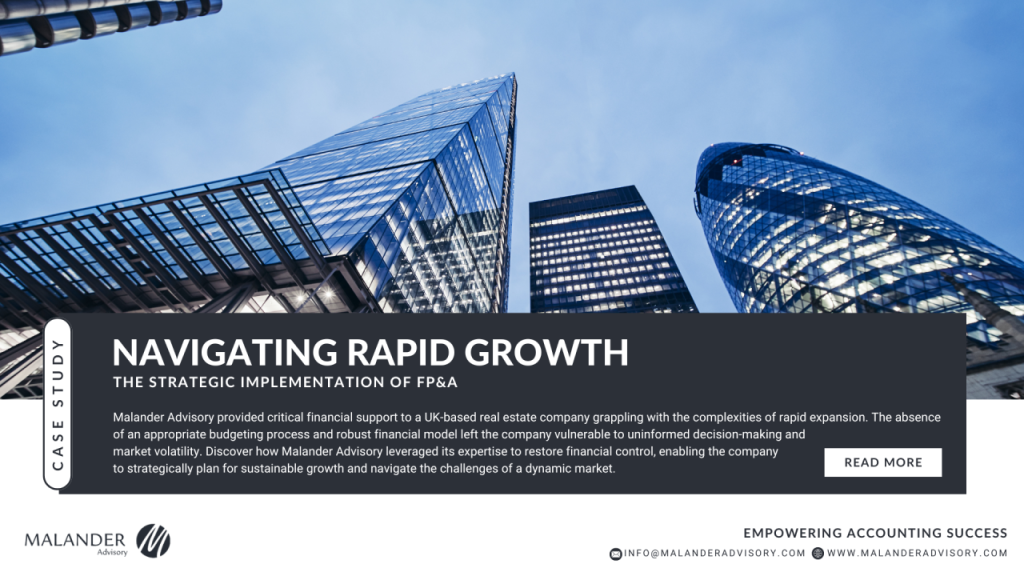Client Overview:
A UK-based property development company experiencing rapid growth faced significant challenges in managing its financial planning and analysis (FP&A) processes. The company had no proper budgeting structure, financial plan, or model, which made it difficult to manage its expanding operations and make informed decisions. Malander Advisory was engaged to provide a solution that would bring financial clarity and control to support the company’s ongoing growth.
The Challenge:
As the company expanded, the absence of a structured financial plan became a critical issue. Key challenges included:
- Lack of Real-Time Financial Data: The company’s financial systems were not equipped to handle the volume and complexity of data generated by its growing operations. This led to delays in financial reporting and a lack of real-time visibility into the company’s financial health.
- Inadequate Financial Modelling: The existing financial models were too simplistic and could not accommodate the various scenarios and complexities that come with a rapidly growing property portfolio. This hindered the company’s ability to forecast cash flow, assess risks, and plan for future investments effectively.
- Lack of Budgeting Structure: The business operated without a formal budgeting process, making it difficult to allocate resources effectively and monitor financial performance. This lack of structure led to inefficient use of funds and increased financial risk.
The Solution:
Malander Advisory was engaged to provide comprehensive FP&A services tailored to the unique needs of the property sector. The solution focused on three key areas:
- Development of a 30-Year Financial Model: o Malander Advisory built a comprehensive 30-year financial model that provided a detailed projection of the company’s financial performance over the long term. This model included income statements, balance sheets, and cash flow statements, allowing the company to forecast future financial outcomes with accuracy. o The financial model was designed to accommodate the complexities of the property development sector, including variable costs, fluctuating market conditions, and the timing of revenue recognition from property sales and leases.
- Implementation of Sensitivity Analysis: o To enhance decision-making, Malander Advisory integrated sensitivity analysis into the financial model. This analysis allowed the company to simulate different scenarios, such as changes in interest rates, property values, and construction costs, and assess their impact on the company’s financial health. o The sensitivity analysis provided management with a clear understanding of potential risks and opportunities, enabling them to make informed strategic decisions and plan for various contingencies.
- Creation of a Structured Budgeting Process: o Malander Advisory introduced a formal budgeting structure, establishing a clear process for setting financial targets, allocating resources, and monitoring performance. This process included the creation of detailed budgets for each department and project, aligned with the overall financial plan. o Regular budget reviews and variance analysis were implemented to ensure that the company stayed on track with its financial goals and could quickly address any deviations.
The Outcome:
The implementation of the FP&A solution by Malander Advisory transformed the financial management capabilities of the property development company. The key outcomes included:
- Long-Term Financial Clarity: The 30-year financial model provided the company with a clear roadmap for its financial future, enabling management to plan confidently for growth and investment.
- Proactive Risk Management: With sensitivity analysis integrated into the financial model, the company was able to identify and mitigate potential risks before they impacted the business. This proactive approach improved the company’s ability to navigate market volatility and economic changes.
- Efficient Resource Allocation: The structured budgeting process allowed the company to allocate resources more effectively, ensuring that funds were used efficiently and aligned with strategic priorities.
Conclusion:
By partnering with Malander Advisory, the UK property development company successfully established a strong financial foundation to support its rapid growth. The creation of a detailed 30-year financial model, combined with sensitivity analysis and a structured budgeting process, provided the company with the tools needed to make informed, strategic decisions and maintain control over its financial operations. This case study demonstrates the critical importance of having robust financial planning and analysis in place, especially for businesses experiencing rapid growth in complex industries like property development.

